Revival Mechanism and Prevention Measures of Composite Landslides: A Case Study of the Wenma Expressway Composite Landslide
Abstract
:1. Introduction
2. Engineering Geological Conditions of the Landslide
2.1. Topographic Features
2.2. Lithology
- Quaternary colluvial deposit (Q4col+dl): mainly gravelly clay with a particle size of 2~13 cm and poor roundness. Soil is red-brown and brown-yellow, with no shaking reaction and high dry strength. The thickness is approximately 5~12 m, distributed mainly on the surface of the mountain (Figure 3a).
- Devonian system Pojiao group sandy mudstone (D1p): Gray-black thin-layered mudstone with partial gray, brown-yellow thin-layered silty mudstone (Figure 3a).
- Devonian system Cuifengshan group argillaceous shale (D1c): The gray-black medium-thick argillaceous shale is approximately 10~20 m thick, with a strong weathering layer. The lower inclination angle is nearly vertical and the upper part is inverted, with an occurrence of 243°∠18° (Figure 3b). The drill core showed that the bottom layer of D1b rock stratum is inverted, and the surface is characterized by bedding landslide. The dip angle in the sliding zone area is nearly vertical.
- The structure along the way in this area is extremely complex, and it is extremely important to understand the rock stratum information of complex landslide masses. Marinos, V. [28] proposed a method for classification of rocks in complex areas. Cotecchia, F. [29] studied the impact of different permeability soils on landslide deformation. Ruggeri, P. [30] pointed out that specific measures should be taken in the engineering design for special soils, and Bromhead, E.N. [31] indicated that landslide sliding often has multiple sliding surfaces. The K39 landslide has large differences in permeability of the rock and soil masses, and has a double-layer sliding surface, so the landslide can be categorized as complex rock masses.
2.3. Geological Structure
2.4. Hydrogeological Conditions
3. Landslide Deformation Zoning Characteristics
3.1. Surface Deformation Characteristics of the Landslide
3.2. Deep Deformation Characteristics of the Landslide
4. Mechanism of Landslide Reactivation
5. Preliminary Stability Analysis of the Landslide
5.1. Calculation Parameters
5.2. Calculation Results
6. Conclusions
- The geological conditions and regional structure of the landslide area are extremely complex. The interface between the Quaternary colluvial deposits and the sandy mudstones of the toe group is the shallow landslide slide zone in Zone I and Zone II, and the deep landslide slide belt in Zone III is between the deep strongly weathered shale and the moderately weathered shale.
- The landslide can be divided into three areas according to the statistics of the surface crack deformation: Zone I, Zone II, and Zone III. We determined that Zone I and Zone II are shallow landslides and Zone III is a deep landslide, according to the monitoring of the deep deformation of the landslide. The surface cracks in Zone I are concentrated near the rear edge retaining structure, and the strike of the cracks is mainly vertical to the sliding direction. The deformation was obviously controlled after drainage treatment. There are historical sliding tension fractures and traction structures in Zone II, and the current deformation is stable without deformation. Zone III is the main sliding area with the longest average fracture length and the deepest sliding depth, and there sliding deformation is always occurring.
- The physical parameters of the sliding body, sliding belt, and sliding bed in Zone III were measured through on-site sampling and indoor tests. The groundwater level in the landslide area was lowered by setting a drainage tunnel, and the results showed that the slope was in critical condition when there was no drainage tunnel or the drainage tunnel depth was 15 m. The slope was basically stable when the drainage tunnel depth was 20 m or 25 m. The slope was stable when the depth of the drainage tunnel reached more than 30 m. The groundwater level is the main factor affecting the landslide deformation. According to the design of on-site support facilities, attention should be paid to the control of the slope groundwater level in the prevention and control of slopes with the same characteristics as the K39 landslide, to prevent the revival of the landslide.
Author Contributions
Funding
Institutional Review Board Statement
Informed Consent Statement
Data Availability Statement
Conflicts of Interest
References
- He, Y.P.; Xie, H.; Cui, P.; Wei, F.Q.; Zhong, D.L.; Gardner, J.S. GIS-based hazard mapping and zonation of debris flows in Xiaojiang Basin, southwestern China. Environ. Geol. 2003, 45, 286–293. [Google Scholar] [CrossRef]
- Zhang, F.Y.; Peng, J.B.; Huang, X.W.; Lan, H.X. Hazard assessment and mitigation of non-seismically fatal landslides in China. Nat. Hazards 2021, 106, 785–804. [Google Scholar] [CrossRef]
- Shang, Y.J.; Park, H.D.; Yang, Z.F.; Yang, J. Distribution of landslides adjacent to the northern side of the Yarlu Tsangpo Grand Canyon in Tibet, China. Environ. Geol. 2005, 48, 721–741. [Google Scholar] [CrossRef]
- Iqbal, J.; Dai, F.; Hong, M.; Tu, X.; Xie, Q. Failure Mechanism and Stability Analysis of an Active Landslide in the Xiangjiaba Reservoir Area, Southwest China. J. Earth Sci. 2018, 29, 646–661. [Google Scholar] [CrossRef]
- Niu, H.; Li, Q.; Zhang, L.; Li, X.; Wang, J. Experimental Study on Failure Mechanism and Mode of Fly-Ash Dam Slope Triggered by Rainfall Infiltration. Appl. Sci. 2022, 12, 9404. [Google Scholar] [CrossRef]
- Wang, L.Q.; Lu, S.; Li, C.D. Study on Formation Mechanism of Yangjiashan Landslide in Enshi City, China. Res. J. Chem. Environ. 2012, 16, 102–107. [Google Scholar]
- Tan, Q.W.; Tang, H.M.; Fan, L.; Xiong, C.R.; Fan, Z.Q.; Zhao, M.; Li, C.; Wang, D.J.; Zou, Z.X. In situ triaxial creep test for investigating deformational properties of gravelly sliding zone soil: Example of the Huangtupo 1# landslide, China. Landslides 2018, 15, 2499–2508. [Google Scholar]
- Han, H.M.; Shi, B.; Zhang, L. Prediction of landslide sharp increase displacement by SVM with considering hysteresis of groundwater change. Eng. Geol. 2021, 280, 105876. [Google Scholar] [CrossRef]
- Luo, X.Q.; Sun, H.; Tham, L.G.; Junaideen, S.M. Landslide Model Test System and Its Application on the Study of Shiliushubao Landslide in Three Gorges Reservoir Area. Soils Found. 2010, 50, 309–317. [Google Scholar] [CrossRef]
- Wang, H.L.; Jiang, Z.H.; Xu, W.Y.; Wang, R.B.; Xie, W.C. Physical model test on deformation and failure mechanism of deposit landslide under gradient rainfall. Bull. Eng. Geol. Environ. 2022, 81, 66. [Google Scholar] [CrossRef]
- Tomic, K.B.; Susic, N.; Uljarevic, M. The Systematization of Analytical and Numerical Methods of Landslide Stability Calculation. Gradevnski Mater. I Konstr.-Build. Mater. Struct. 2018, 61, 129–160. [Google Scholar]
- Sun, H.Y.; Wu, X.; Wang, D.F.; Xu, H.D.; Liang, X.; Shang, Y.Q. Analysis of deformation mechanism of landslide in complex geological conditions. Bull. Eng. Geol. Environ. 2019, 78, 4311–4323. [Google Scholar] [CrossRef]
- Tang, H.M.; Gong, W.P.; Li, C.D.; Wang, L.Q.; Juang, C.H. A new framework for characterizing landslide deformation: A case study of the Yu-Kai highway landslide in Guizhou, China. Bull. Eng. Geol. Environ. 2019, 78, 4291–4309. [Google Scholar] [CrossRef]
- Wang, J.J.; Xiao, L.L.; Zhang, J.; Zhu, Y.B. Deformation characteristics and failure mechanisms of a rainfall-induced complex landslide in Wanzhou County, Three Gorges Reservoir, China. Landslides 2020, 17, 419–431. [Google Scholar] [CrossRef]
- Li, C.D.; Long, J.J.; Liu, Y.; Li, Q.; Liu, W.Q.; Feng, P.F.; Li, B.C.; Xian, J.Y. Mechanism analysis and partition characteristics of a recent highway landslide in Southwest China based on a 3D multi-point deformation monitoring system. Landslides 2021, 18, 2895–2906. [Google Scholar] [CrossRef]
- Sharma, R.H.; Nakagawa, H. Numerical model and flume experiments of single- and two-layered hillslope flow related to slope failure. Landslides 2010, 7, 425–432. [Google Scholar] [CrossRef]
- Zhu, D.P.; He, L. Study on the Influence of Groundwater on Landslide Stability in the Three Gorges Reservoir. Arab. J. Sci. Eng. 2022, 47, 4211–4223. [Google Scholar]
- Duan, G.H.; Chen, D.; Niu, R.Q. Forecasting Groundwater Level for Soil Landslide Based on a Dynamic Model and Landslide Evolution Pattern. Water 2019, 11, 2163. [Google Scholar] [CrossRef]
- Zhu, D.P.; Yan, E.C.; Huang, L.; He, Q.D. Action Mode of Groundwater on Landslide Mass and Standard Variation Curve of Landslide Stability with rise of Reservoir Water. Disaster Adv. 2012, 5, 721–725. [Google Scholar]
- Wei, Z.L.; Wang, D.F.; Sun, H.Y.; Yan, X. Comparison of a physical model and phenomenological model to forecast groundwater levels in a rainfall-induced deep-seated landslide. J. Hydrol. 2020, 586, 124894. [Google Scholar] [CrossRef]
- Akpan, A.E.; Ekwok, S.E.; Ebong, E.D. Seasonal reversals in groundwater flow direction and its role in the recurrent Agwagune landslide problem: A geophysical and geological appraisal. Environ. Earth Sci. 2016, 75, 429. [Google Scholar] [CrossRef]
- Beyabanaki, S.; Bagtzoglou, A.C.; Anagnostou, E.N. Effects of groundwater table position, soil strength properties and rainfall on instability of earthquake-triggered landslides. Environ. Earth Sci. 2016, 75, 358. [Google Scholar] [CrossRef]
- Sun, H.Y.; Wong, L.; Shang, Y.Q.; Shen, Y.J.; Lu, Q. Evaluation of drainage tunnel effectiveness in landslide control. Landslides 2010, 7, 445–454. [Google Scholar] [CrossRef]
- Zheng, J.; Wang, J.C.; Guo, J.C.; Zhang, Y.Q.; Lu, Q.; Sun, H.Y. A siphon drainage system with variable diameters for landslides: Concept, calculation, and validation. J. Hydrol. 2021, 597, 126305. [Google Scholar] [CrossRef]
- Wang, Z.L.; Shang, Y.Q.; Sun, H.Y. Optimal location and effect judgment on drainage tunnels for landslide prevention. J. Cent. South Univ. 2013, 20, 2041–2053. [Google Scholar] [CrossRef]
- Miao, F.S.; Wu, Y.P.; Torok, A.; Li, L.W.; Xue, Y. Centrifugal model test on a riverine landslide in the Three Gorges Reservoir induced by rainfall and water level fluctuation. Geosci. Front. 2022, 13, 101378. [Google Scholar] [CrossRef]
- Yang, Z.Q.; Fan, X.L.; Yang, Y.; Hou, K.P.; Du, J.; Chen, X.G.; Mi, Y.P.; Jiang, C.P.; Zhang, J.; Guo, Y.F. Deformation patterns and failure mechanism of high and steep stratified rock slopes with upper steep and lower gentle style induced by step-by-step excavations. Environ. Earth Sci. 2022, 81, 229. [Google Scholar] [CrossRef]
- Marinos, V. A revised, geotechnical classification GSI system for tectonically disturbed heterogeneous rock masses, such as flysch. Bull. Eng. Geol. Environ. 2019, 78, 899–912. [Google Scholar] [CrossRef]
- Cotecchia, F.; Vitone, C.; Santaloia, F.; Pedone, G.; Bottiglieri, O. Slope instability processes in intensely fissured clays: Case histories in the Southern Apennines. Landslides 2015, 12, 877–893. [Google Scholar] [CrossRef]
- Ruggeri, P.; Fruzzetti, V.; Scarpelli, G. Design Strategies to Mitigate Slope Instabilities in Structurally Complex Formations. Geosciences 2020, 10, 82. [Google Scholar] [CrossRef]
- Bromhead, E.N. Reflections on the residual strength of clay soils, with special reference to bedding-controlled landslides. Q. J. Eng. Geol. Hydrogeol. 2013, 46, 132–154. [Google Scholar] [CrossRef]
- Zheng, Y.; Chen, C.X.; Liu, T.T.; Xia, K.Z.; Sun, C.Y.; Chen, L.L. Analysis of a retrogressive landslide with double sliding surfaces: A case study. Environ. Earth Sci. 2020, 79, 21. [Google Scholar] [CrossRef]
- Yan, Z.L.; Wang, J.J.; Chai, H.J. Influence of water level fluctuation on phreatic line in silty soil model slope. Eng. Geol. 2010, 113, 90–98. [Google Scholar] [CrossRef]
- Bronnimann, C.; Stahli, M.; Schneider, P.; Seward, L.; Springman, S.M. Bedrock exfiltration as a triggering mechanism for shallow landslides. Water Resour. Res. 2013, 49, 5155–5167. [Google Scholar] [CrossRef]
- Ramkrishnan, R.; Sharma, A.; Viswanathan, K.; Ravichandran, D. Determination of critical phreatic level for landslide assessment using a scaled down laboratory model. Int. J. Geotech. Eng. 2022, 16, 239–255. [Google Scholar] [CrossRef]
- Yin, J.; Miao, Y.H. Undrained Shear Strength Characteristics of Natural Silty Clay. In PROGRESS IN INDUSTRIAL AND CIVIL ENGINEERING II, PTS 1-4; 2nd International Conference on Civil, Architectural and Hydraulic Engineering (ICCAHE 2013); Yang, W., Liang, J., Eds.; Trans Tech Publications Ltd.: Stafa-Zurich, Switzerland, 2013; Volume 405–408, pp. 285–289. [Google Scholar]
- Shi, X.S.; Herle, I.; Yin, J.H. Laboratory Study of the Shear Strength and State Boundary Surface of a Natural Lumpy Soil. J. Geotech. Geoenviron. 2018, 144, 04018093. [Google Scholar] [CrossRef]
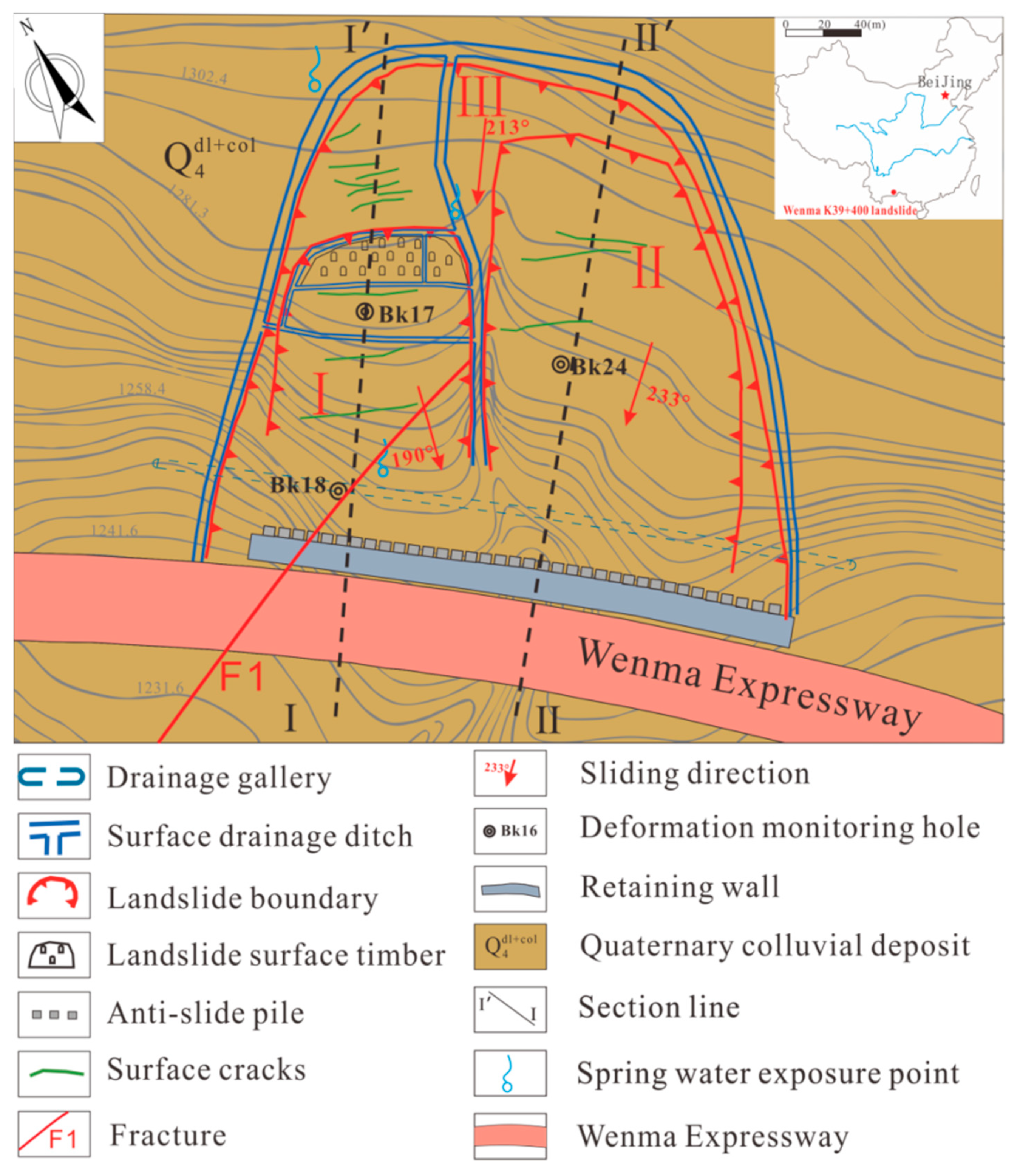
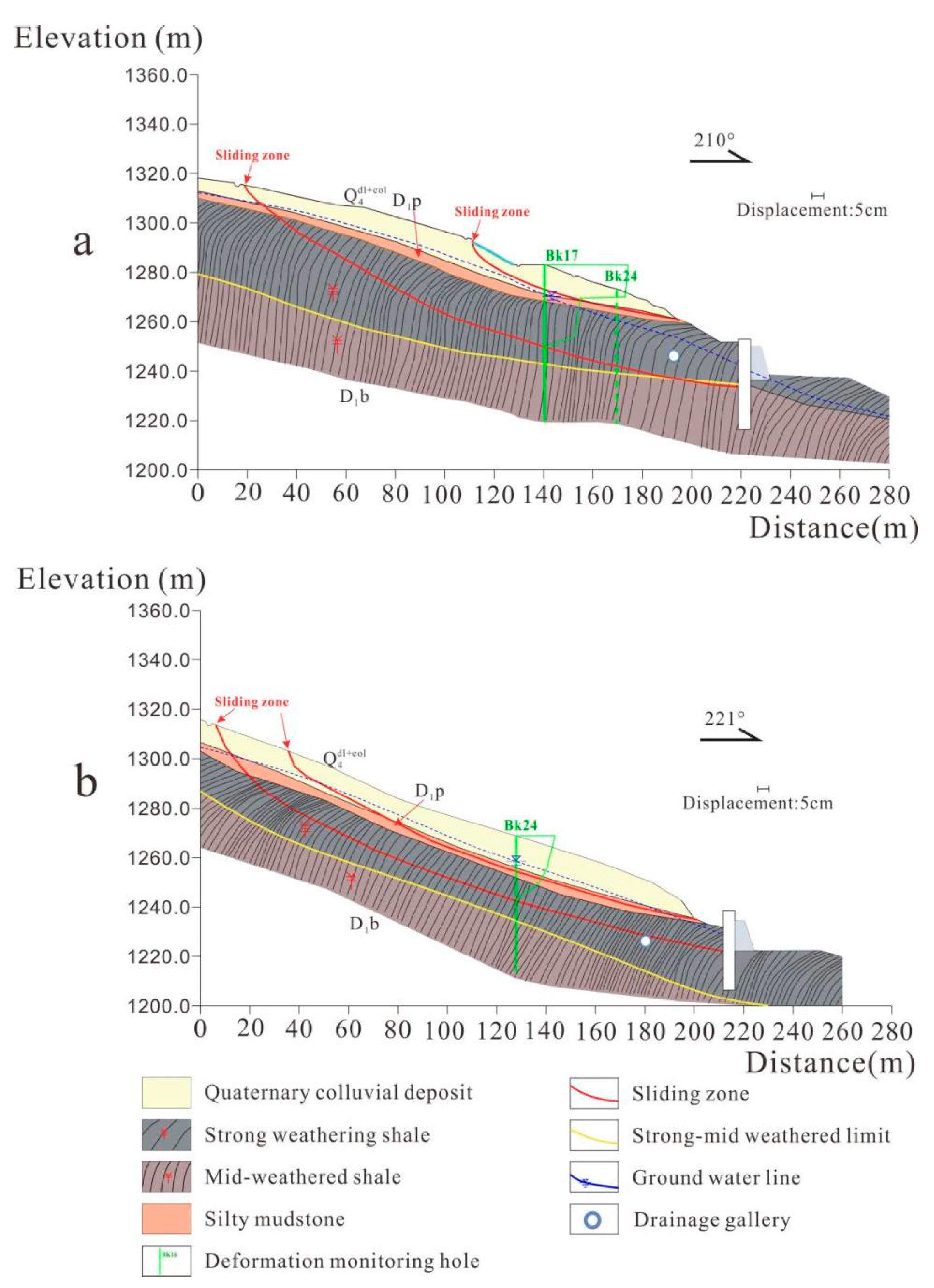
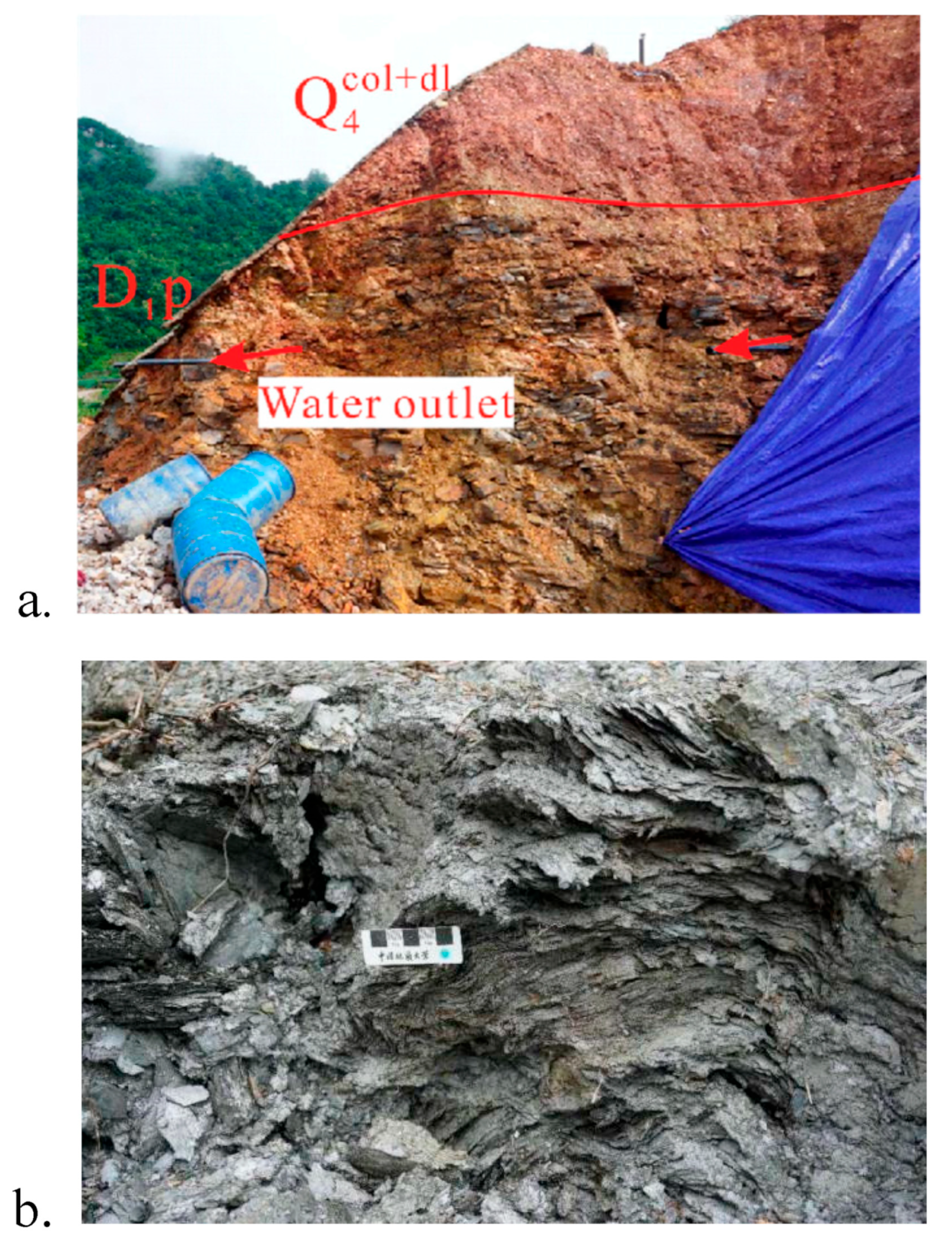
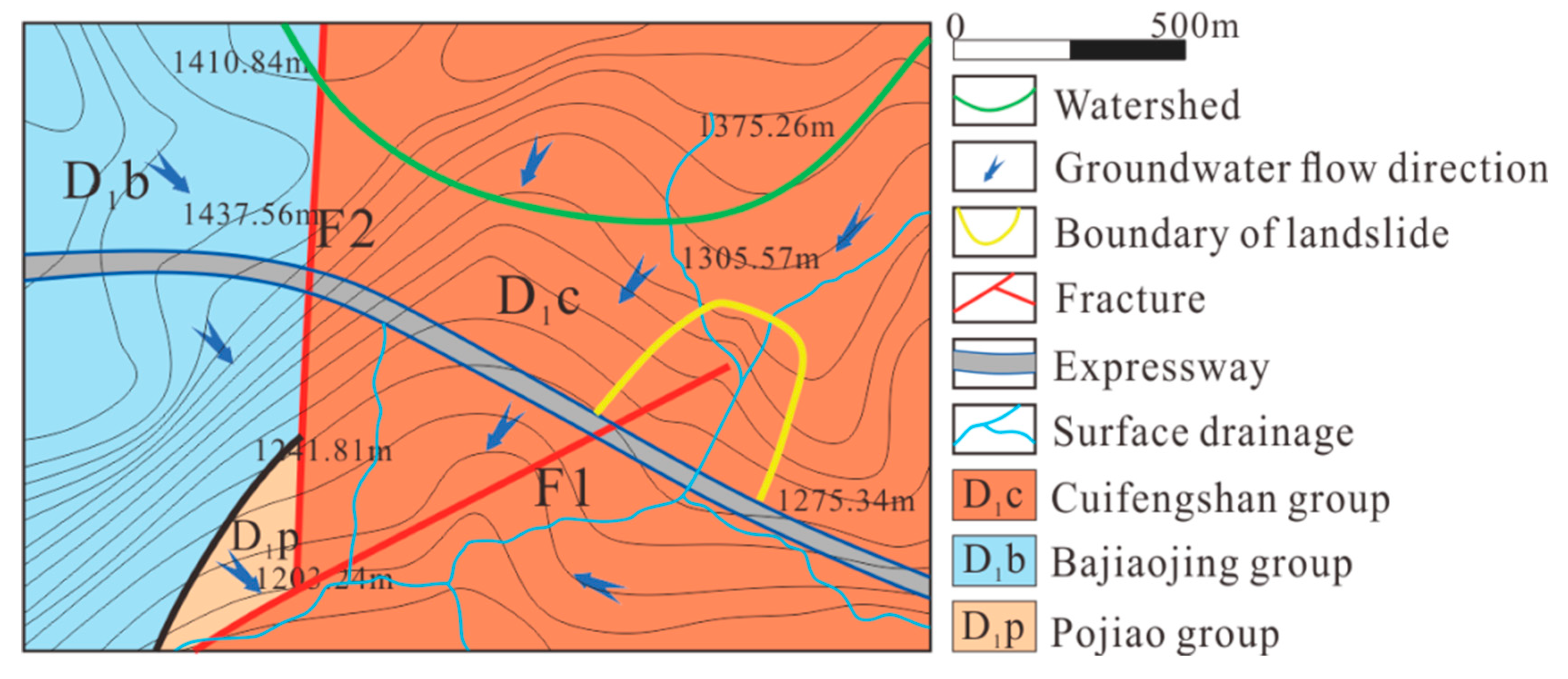
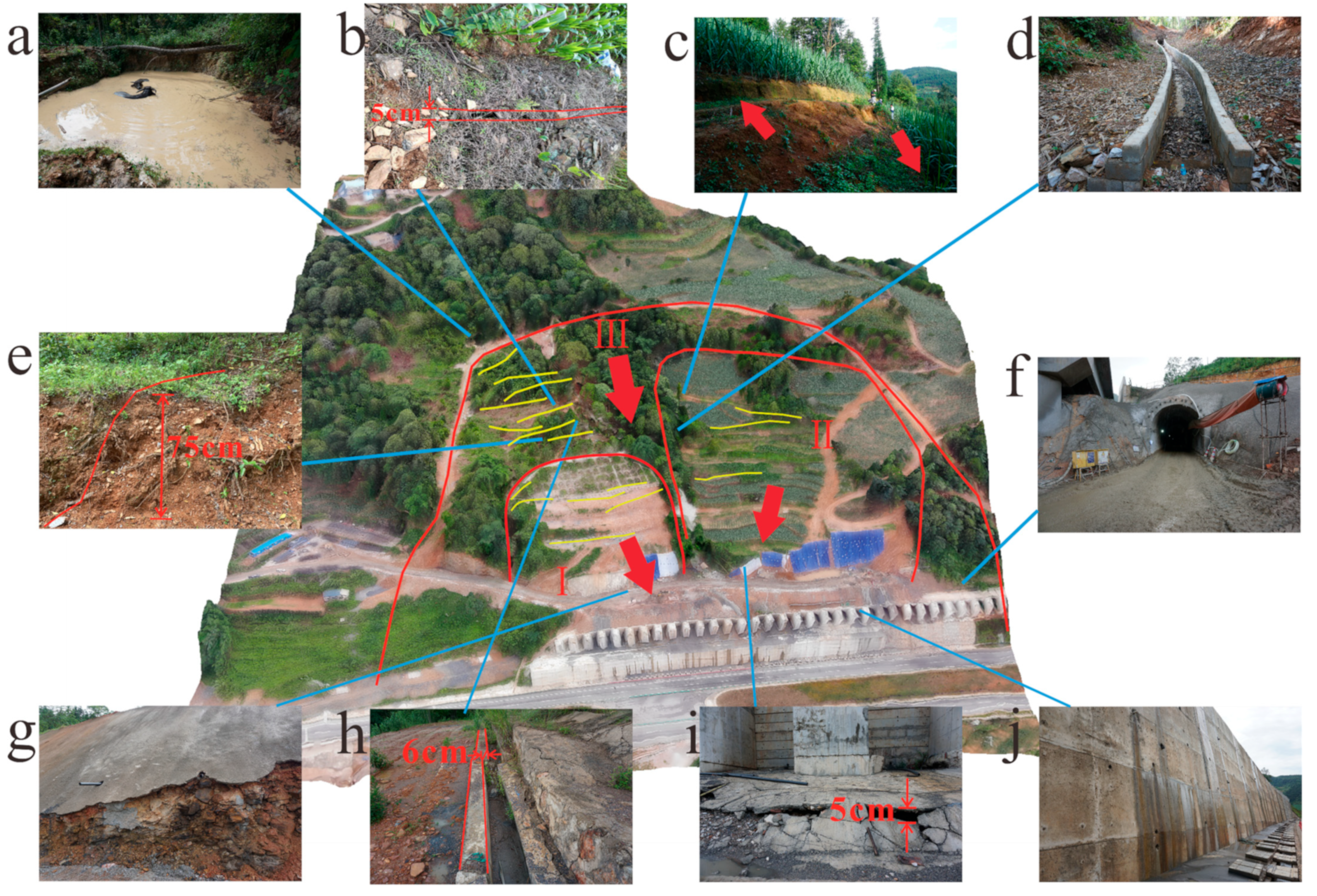
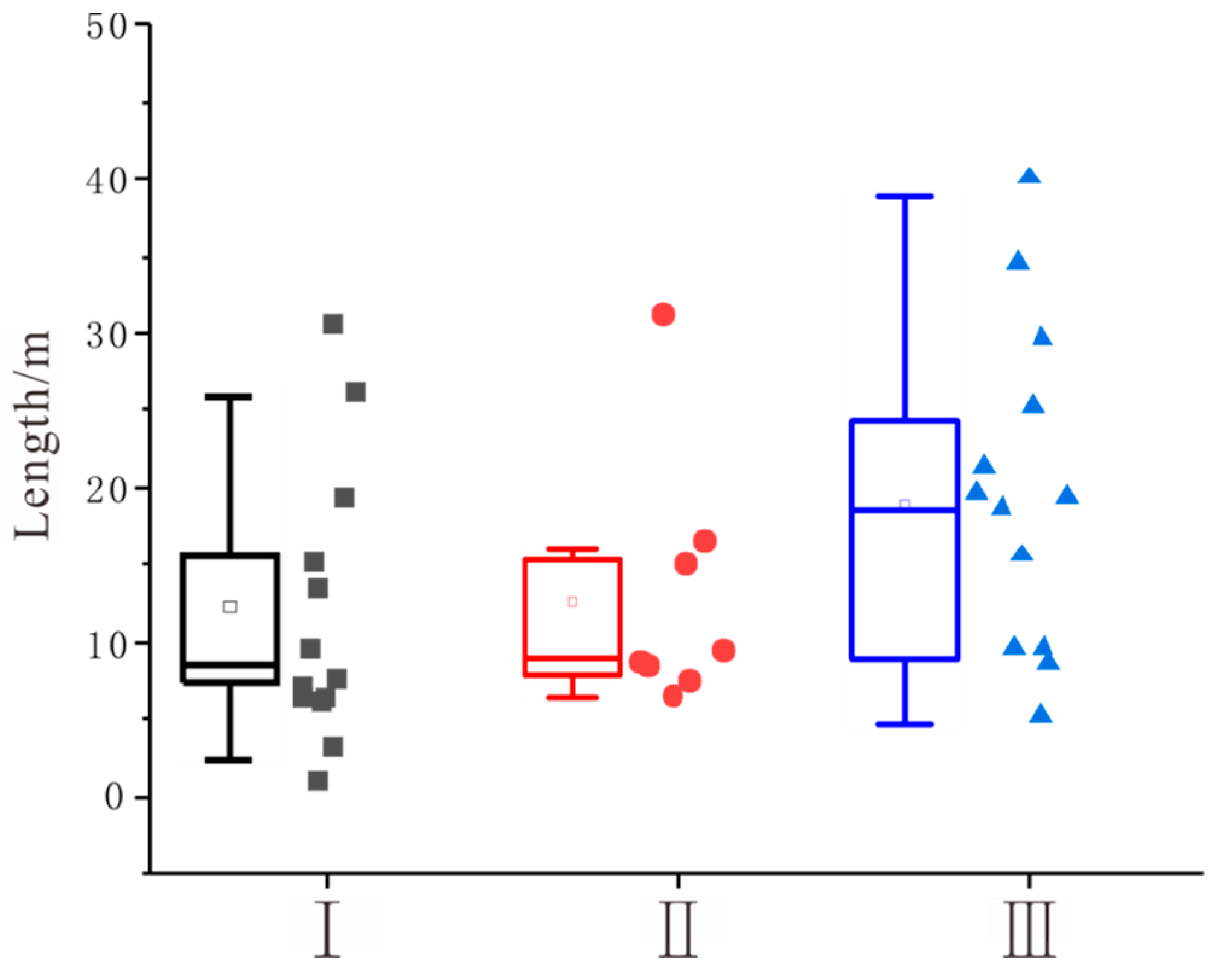

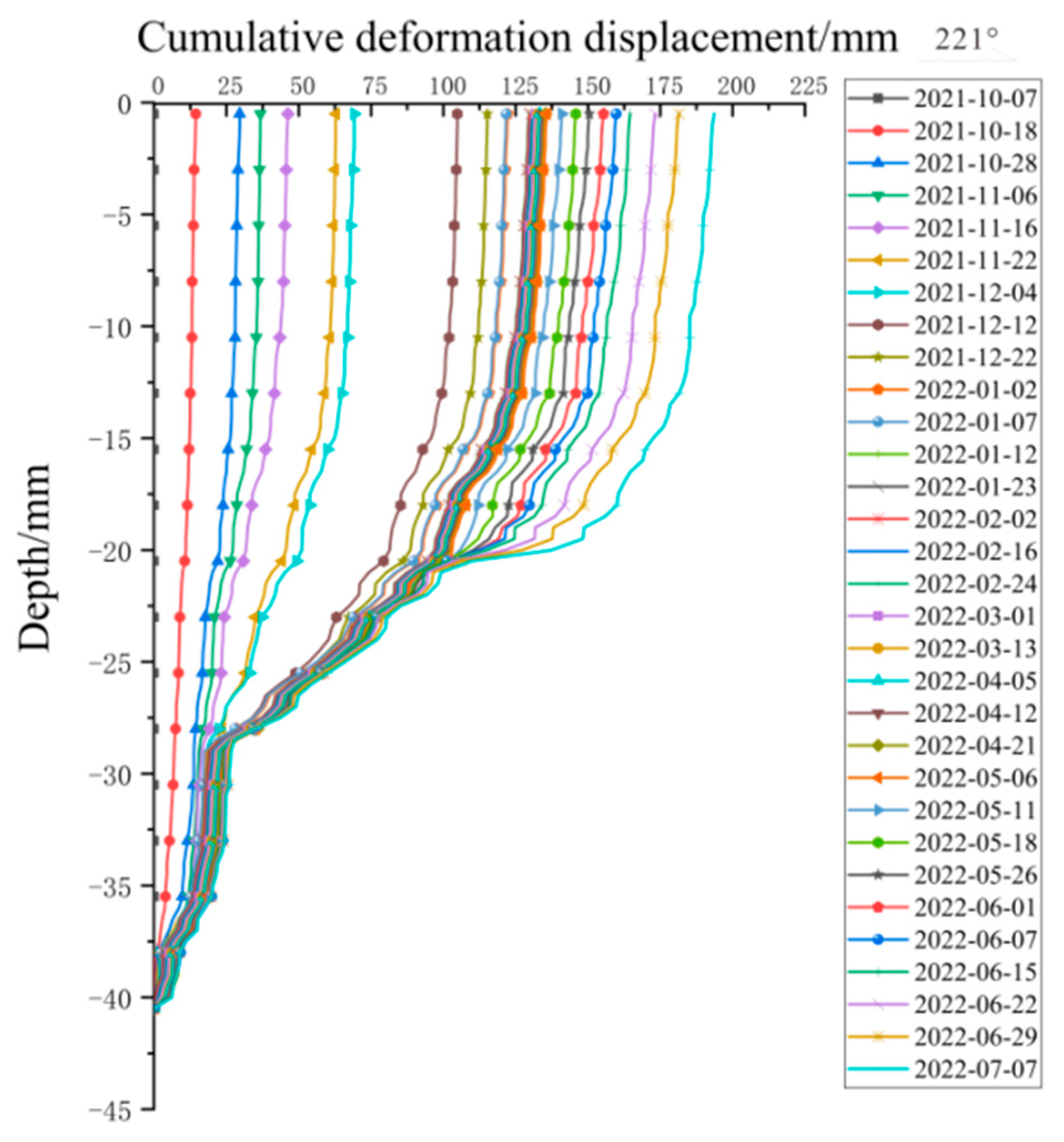
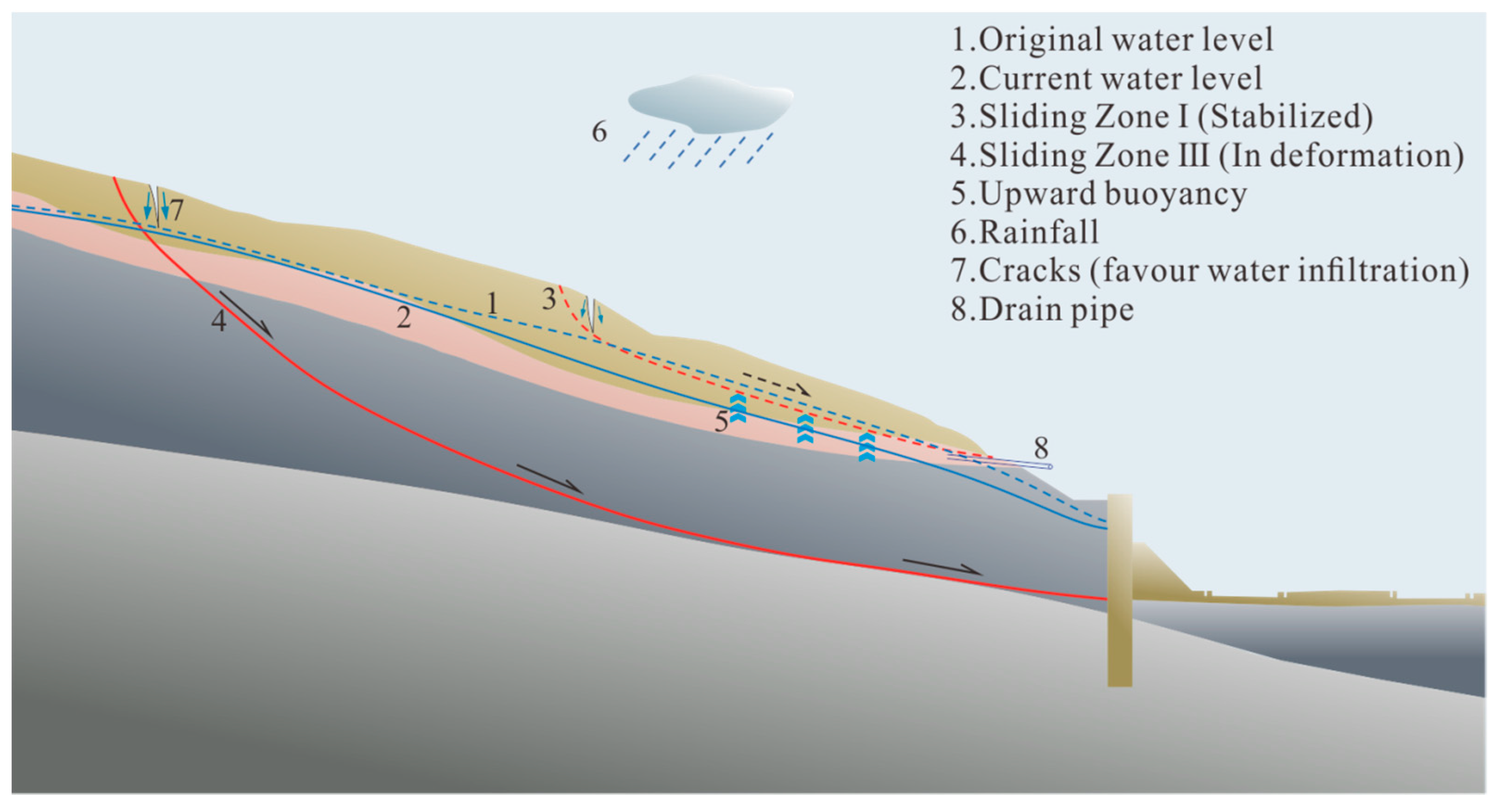
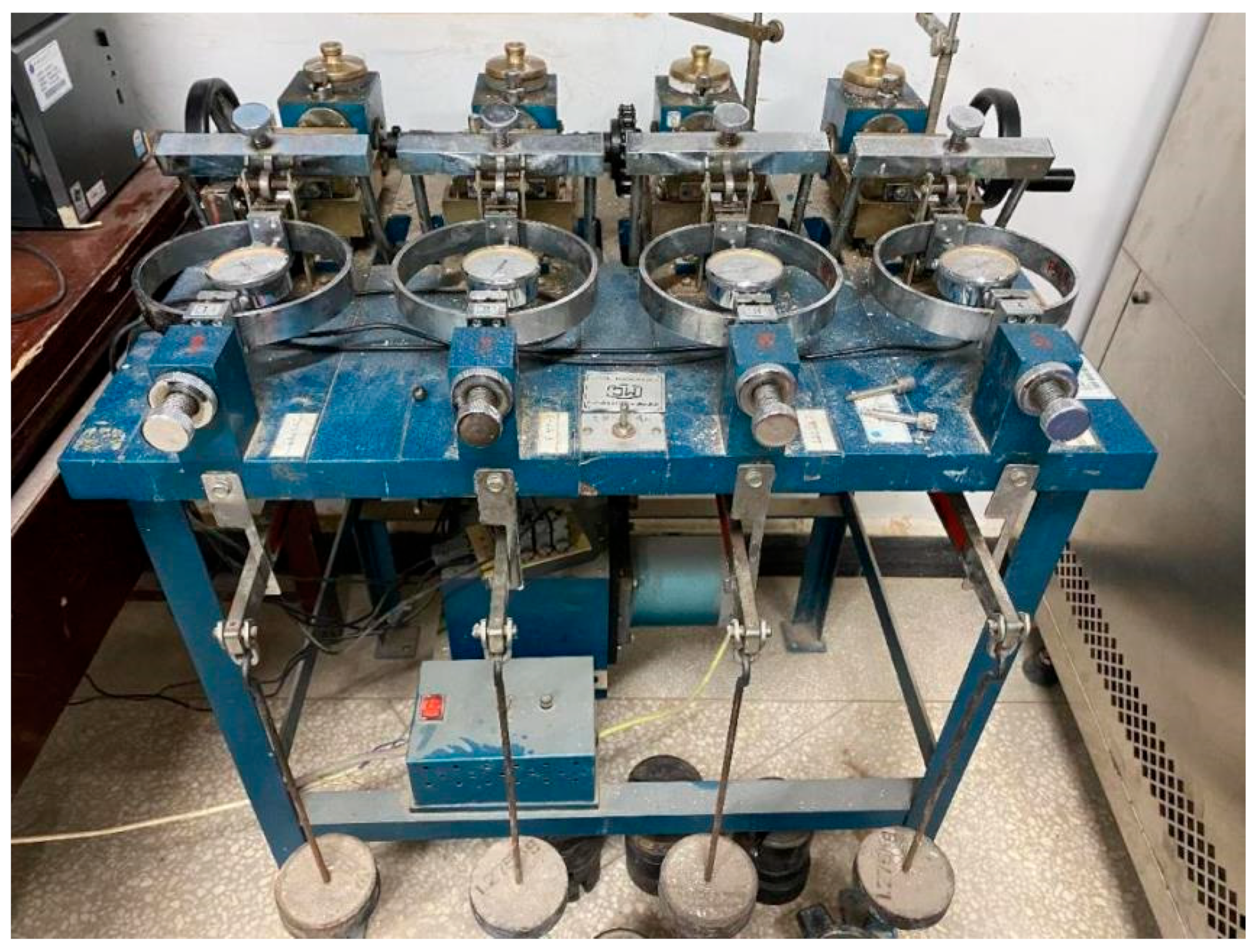
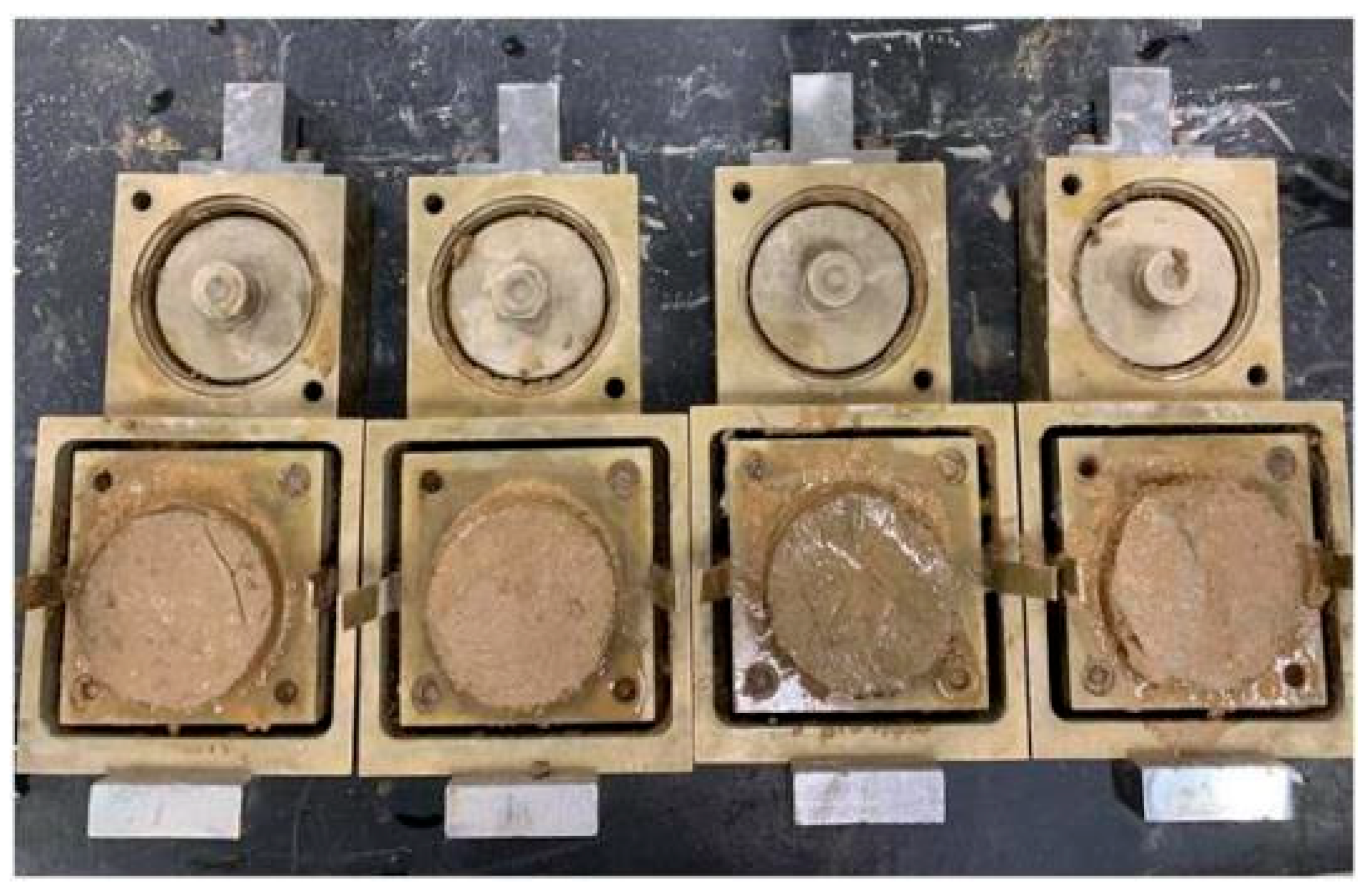
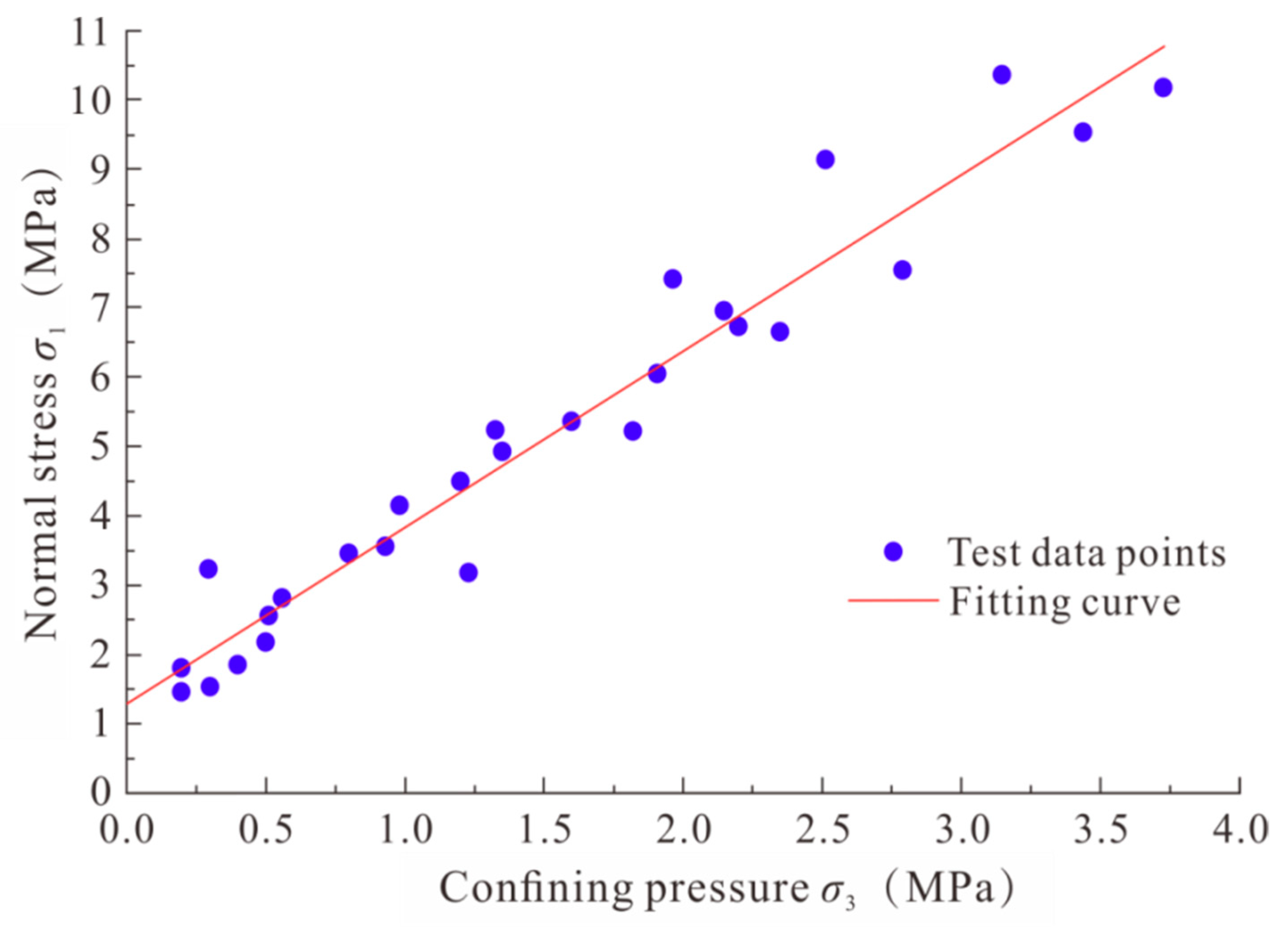

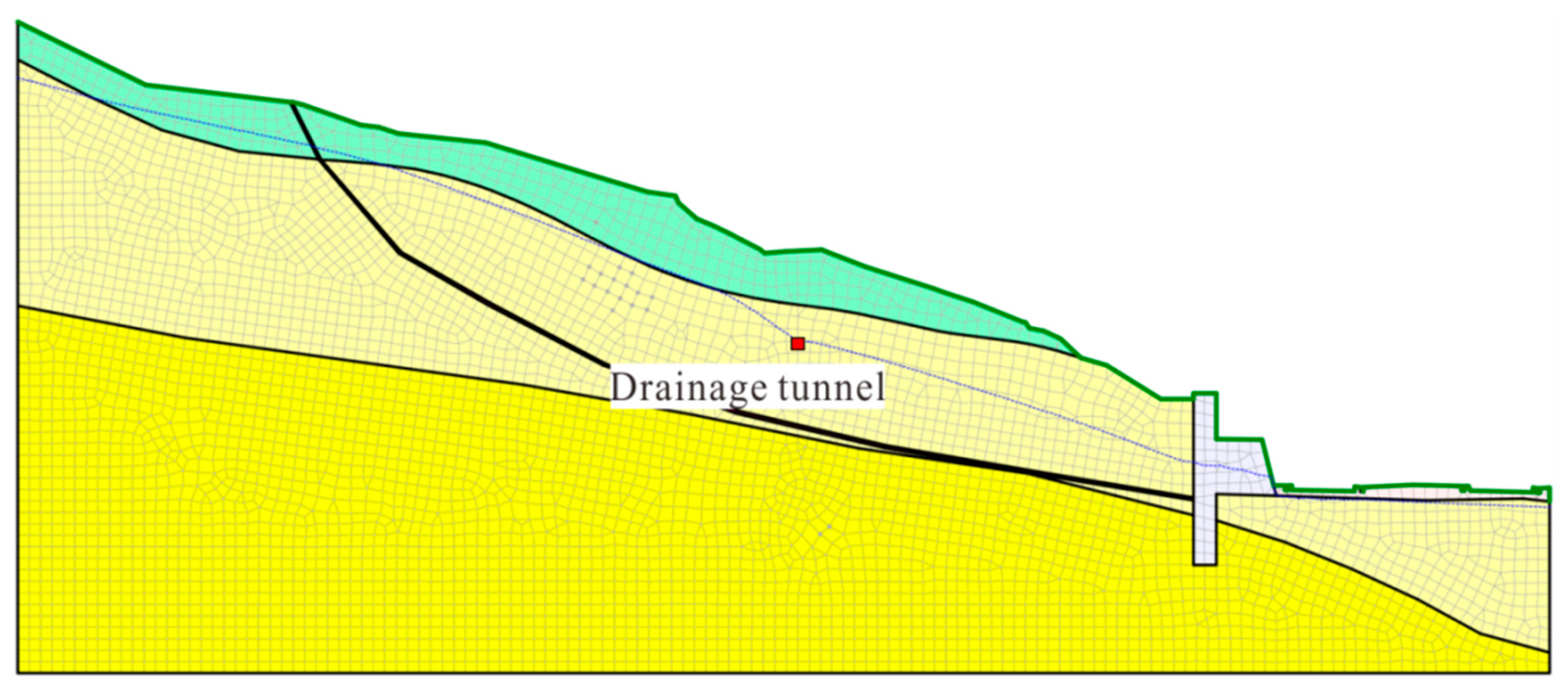
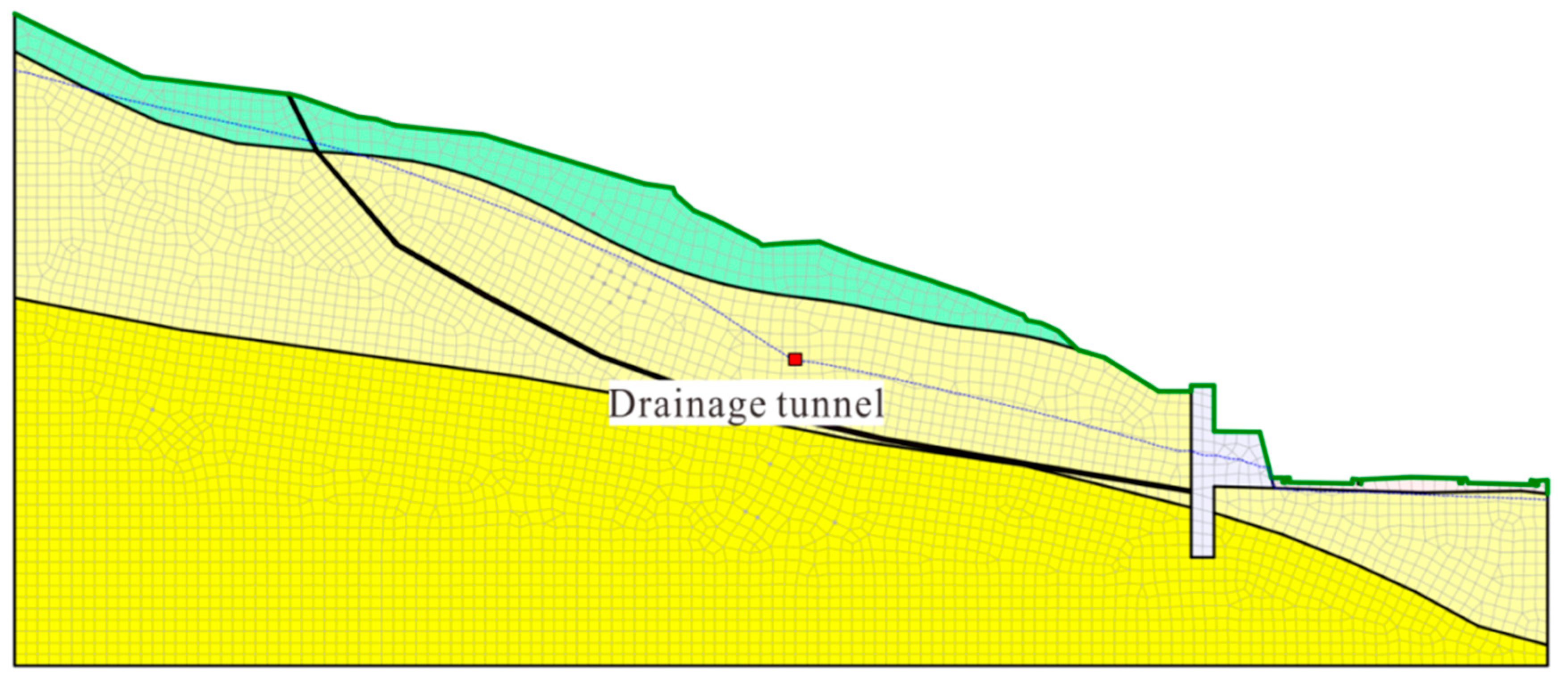

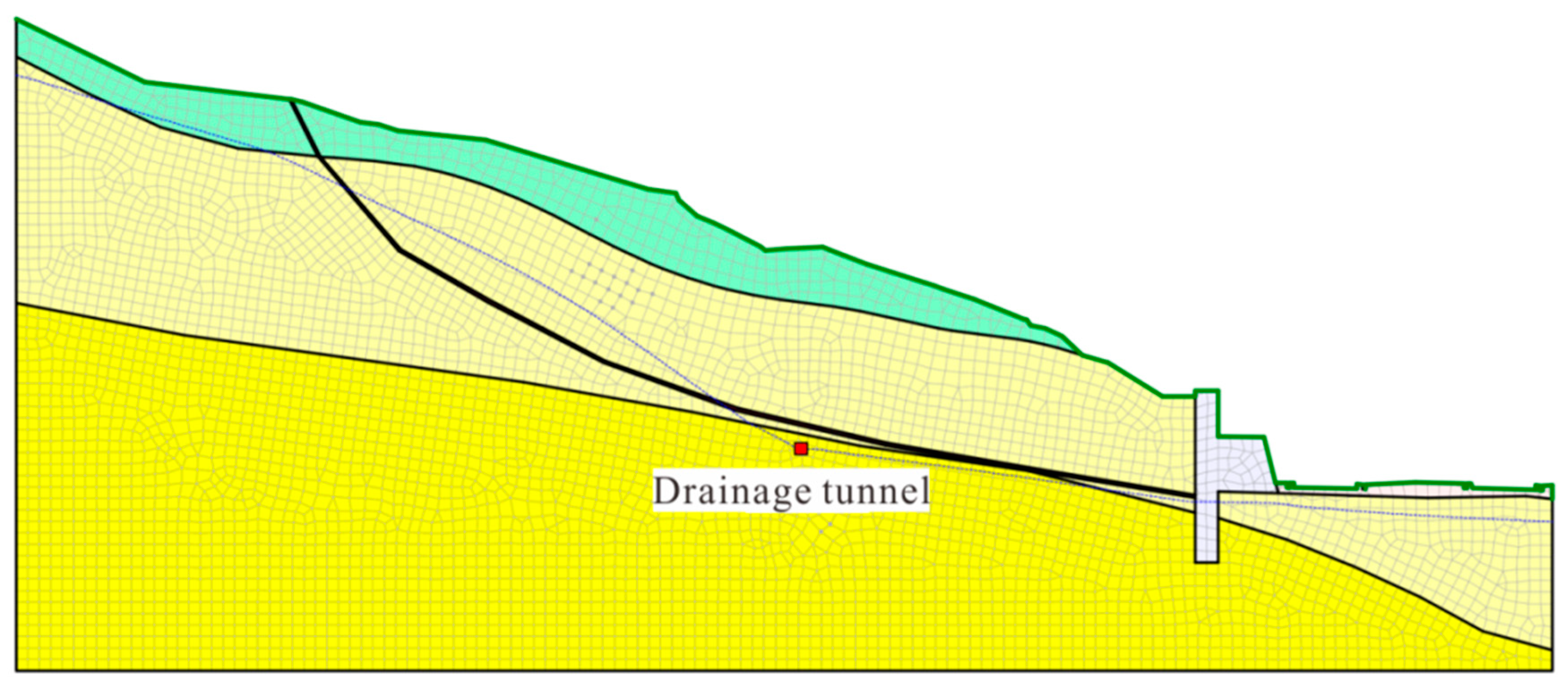

| Specimen | Shear Strength Parameters | Sample State | |
|---|---|---|---|
| Cohesion (kPa) | Angle of Internal Friction (°) | ||
| BK17-1 | 32 | 16 | Natural |
| BK17-2 | 34 | 16 | Natural |
| BK17-3 | 34 | 16 | Natural |
| BK17-4 | 33 | 16 | Natural |
| BK17-5 | 37 | 17 | Natural |
| BK17-6 | 16 | 11 | Saturation |
| BK17-7 | 16 | 11 | Saturation |
| BK17-8 | 18 | 11 | Saturation |
| BK17-9 | 17 | 11 | Saturation |
| BK17-10 | 20 | 11 | Saturation |
| Rock Soil Mass Types | Unit Weight (kN/m3) | Angle of Internal Friction (°) | Cohesion (kPa) | Saturated Permeability Coefficient (cm/s) | ||||
|---|---|---|---|---|---|---|---|---|
| Natural | Rainfall | Natural | Rainfall | Natural | Rainfall | Vertical | Horizontal | |
| Sliding zone soil | 18 | 20 | 19 | 16 | 20 | 13 | 7.1 × 10−4 | 5.2 × 10−4 |
| Strong-weathered shale | 19 | 21 | 21 | 17 | 22 | 16 | 9.4 × 10−4 | 8.8 × 10−4 |
| Mid-weathered shale | / | 24 | 452 | 3.4 × 10−6 | 3.1 × 10−6 | |||
| Depth of Drainage Tunnel | No Drainage Tunnel | 15 m | 20 m | 25 m | 30 m |
|---|---|---|---|---|---|
| Stability | 1.065 | 1.193 | 1.212 | 1.301 | 1.347 |
Disclaimer/Publisher’s Note: The statements, opinions and data contained in all publications are solely those of the individual author(s) and contributor(s) and not of MDPI and/or the editor(s). MDPI and/or the editor(s) disclaim responsibility for any injury to people or property resulting from any ideas, methods, instructions or products referred to in the content. |
© 2023 by the authors. Licensee MDPI, Basel, Switzerland. This article is an open access article distributed under the terms and conditions of the Creative Commons Attribution (CC BY) license (https://creativecommons.org/licenses/by/4.0/).
Share and Cite
Bao, X.; Cui, D.; Peng, J.; Liao, M.; Zhang, G. Revival Mechanism and Prevention Measures of Composite Landslides: A Case Study of the Wenma Expressway Composite Landslide. Appl. Sci. 2023, 13, 2449. https://doi.org/10.3390/app13042449
Bao X, Cui D, Peng J, Liao M, Zhang G. Revival Mechanism and Prevention Measures of Composite Landslides: A Case Study of the Wenma Expressway Composite Landslide. Applied Sciences. 2023; 13(4):2449. https://doi.org/10.3390/app13042449
Chicago/Turabian StyleBao, Xun, Deshan Cui, Jiale Peng, Mingke Liao, and Guangcheng Zhang. 2023. "Revival Mechanism and Prevention Measures of Composite Landslides: A Case Study of the Wenma Expressway Composite Landslide" Applied Sciences 13, no. 4: 2449. https://doi.org/10.3390/app13042449
APA StyleBao, X., Cui, D., Peng, J., Liao, M., & Zhang, G. (2023). Revival Mechanism and Prevention Measures of Composite Landslides: A Case Study of the Wenma Expressway Composite Landslide. Applied Sciences, 13(4), 2449. https://doi.org/10.3390/app13042449







